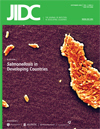The potential role of mobile phones in the spread of bacterial infections
DOI:
https://doi.org/10.3855/jidc.556Keywords:
Mobile phone, bacteria, disease, transmission, nosocomialAbstract
BACKGROUND: Mobile phones are indispensable accessories both professionally and socially but they are frequently used in environments of high bacteria presence. This study determined the potential role of mobile phones in the dissemination of diseases. METHODOLOGY: Specifically, 400 swab samples from mobile phones were collected and divided into groups categorized by the owners of the phones as follows: Group A was comprised of 100 food vendors; Group B, 104 lecturers/students; Group C, 106 public servants; and Group D, 90 health workers. Samples were cultured and the resulting isolates were identified and subjected to antimicrobial susceptibility tests by standard procedures. RESULTS: The results revealed a high percentage (62.0%) of bacterial contamination. Mobile phones in Group A had the highest rate of contamination (92; 37%), followed by Group B (76; 30.6%), Group C (42; 16.9%), and Group D (38; 15.3%). Coagulase negative Staphylococcus (CNS) was the most prevalent bacterial agent from mobile phones in Group A (50.1%) and least from phones in Group D (26.3), followed by S. aureus. Other bacterial agents identified were Enterococcus feacalis, Pseudomonas aeruginosa, Escherichia coli, and Klebsiella spp. There was no statistical significance difference (P < 0.05) in the occurrence of S. aureus, the most frequently identified pathogenic bacterial agent isolated from the mobile phones in the study groups. Fluoroquinolones and third-generation cephalosporin were found to be effective against most isolates. CONCLUSION: Mobile phones may serve as vehicles of transmission of both hospital and community-acquired bacterial diseases. Strict adherence to infection control, such as hand washing, is advocated.Downloads
Published
2009-09-15
How to Cite
1.
Akinyemi KO, Atapu AD, Adetona OO, Coker AO (2009) The potential role of mobile phones in the spread of bacterial infections. J Infect Dev Ctries 3:628–632. doi: 10.3855/jidc.556
Issue
Section
Brief Original Articles
License
Authors who publish with this journal agree to the following terms:
- Authors retain copyright and grant the journal right of first publication with the work simultaneously licensed under a Creative Commons Attribution License that allows others to share the work with an acknowledgement of the work's authorship and initial publication in this journal.
- Authors are able to enter into separate, additional contractual arrangements for the non-exclusive distribution of the journal's published version of the work (e.g., post it to an institutional repository or publish it in a book), with an acknowledgement of its initial publication in this journal.
- Authors are permitted and encouraged to post their work online (e.g., in institutional repositories or on their website) prior to and during the submission process, as it can lead to productive exchanges, as well as earlier and greater citation of published work (See The Effect of Open Access).








